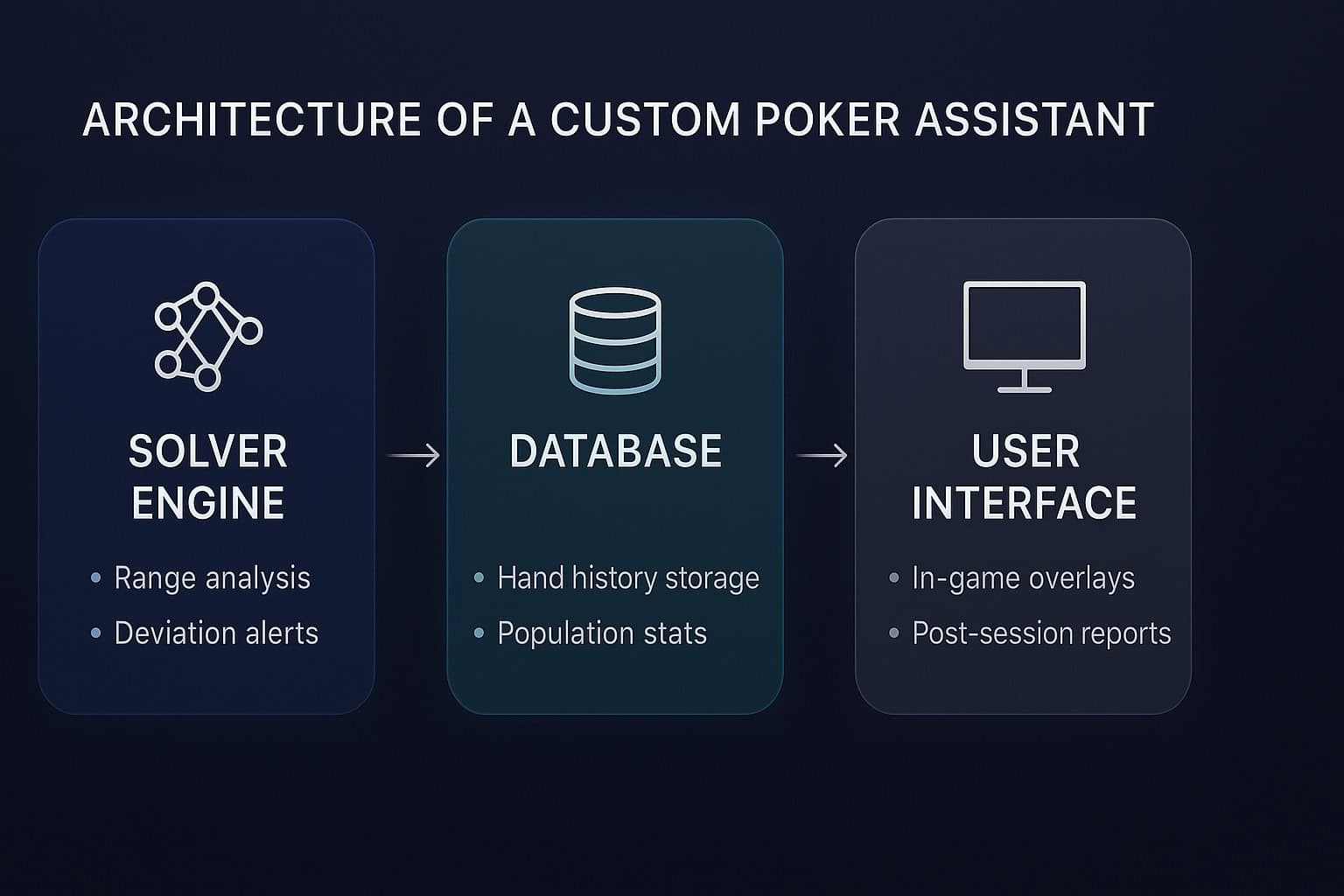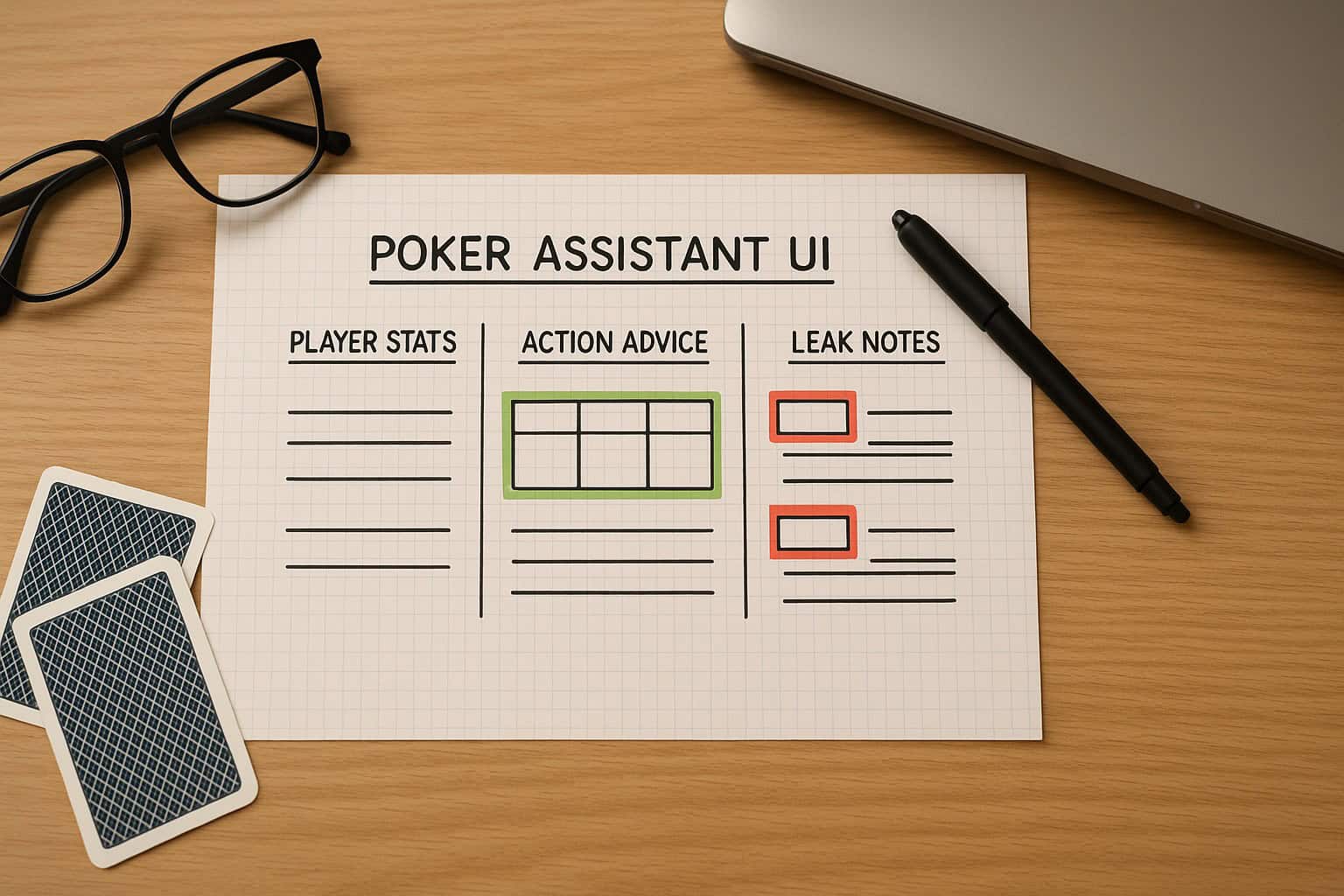
Build a Custom Poker Assistant in 10 Steps
Why Build Your Own Poker Assistant?
If you’re serious about dominating online poker in 2025, you already know that information is everything. That’s why more players in 2025 decide to build a poker assistant instead of relying only on generic tools. The real edge comes from building a poker assistant customized to your own tendencies, leaks, and goals.
Think of it like having a personal coach, data scientist, and note-taker rolled into one. Whether you want to automate note-taking, recommend GTO adjustments on the fly, or analyze population tendencies more deeply, a custom-built assistant puts you ahead of the curve.
And with modern open-source libraries, no-code tools, and a reasonable budget, you don’t need a PhD or a 10-person data team to get started. You need a methodical approach — and a willingness to experiment.
Here’s your step-by-step playbook.

1. Define Your Scope and Goals to Build a Poker Assistant
Before you touch a single line of code or subscribe to a solver API, define what your assistant will do.
- Do you want it to give live reminders about ranges?
- Tag and organize hand histories?
- Run post-session exploit reports?
- Provide preflop vs. postflop deviation alerts?
Clear scope is the foundation if you want to successfully build a poker assistant that lasts.
Don’t try to build everything at once. Choose one core feature, then expand later. Sketch it on paper. Pretend you’re explaining it to a friend. If you can’t articulate its purpose, you’re not ready to build.
2. Choose Your Tech Stack for the Poker Assistant
Your next step is picking the tools you’ll use to build the assistant. In 2025, you have a wealth of options:
- Python remains king for scripting, data parsing, and AI modeling
- JavaScript/Node works well for browser overlays or extensions
- SQLite/Postgres can store hand histories and user data
- React (or similar) can power a slick user interface
- No-code tools like Zapier or n8n can stitch together basic workflows
If you prefer an “old school” desktop vibe, frameworks like Electron let you build cross-platform apps. Modern language models (think GPT-based tools) can even help you write boilerplate faster. With this stack, it becomes much easier to build a poker assistant quickly, even without a full dev team.
3. Build a Clean Data Pipeline
Your assistant will live or die on clean data. That means consistent hand histories, correct parsing, and no duplicates.
- Download hand histories regularly from your poker sites
- Parse them into a normalized schema (e.g., JSON with player, position, action, bet size, timestamp)
- Store them in a small database
- Design an easy way to query: “Show me all BTN 3-bet hands from the last 30 days”
Dirty data = garbage insights. Get this foundation right early. Most failed attempts to build a poker assistant collapse here — at the data pipeline.
4. Integrate Solvers for GTO Baselines

Once you have clean data, you’ll want your assistant to benchmark your play against GTO. That’s where solvers come in.
You can integrate:
- PioSOLVER for highly customizable nodes
- GTO+ for more budget-friendly analysis
- Simple Postflop for rapid review
- Or even public GTO libraries if you don’t want to solve from scratch
Your assistant should match parsed hand actions to a GTO baseline, then flag big deviations. For example, if you’re calling 4-bets too wide from the SB, a simple alert like “SB 4-bet defense too high” can save you thousands in the long run.
5. Automate Note-Taking
One of the best uses of a custom assistant is automatic note-taking. Humans forget, but code remembers everything.
- When you mark a villain’s odd line, store it
- When a player shows down an unexpected bluff, log it
- Build a simple tagging system: date, site, stakes, note text
Modern natural language models (even open-source ones) can help classify these notes into categories, so you aren’t scrolling through chaos after a thousand hands.
6. Add Exploit Data Tracking
If you want a true edge, teach your assistant to exploit common pool mistakes. For example:
- Identify players who fold too much to turn barrels
- Spot opponents who almost never check-raise
- Track bet sizing tells over large samples
This is where you move beyond static charts and really build a poker assistant that exploits opponents. You can feed this data to your assistant to output small exploit adjustments: “This player folds to 3-bets 78% — consider 3-betting wider.”
Add enough of these flags, and your bot becomes a high-powered assistant coach instead of a static range chart.
7. Design a User Interface That Feels Natural

All that data is worthless if you can’t access it in-game or between sessions. You want a simple, low-cognitive-load design.
- Use clear color-coding (e.g., red = leak, green = exploit opportunity)
- Place critical data within one click
- Show “confidence scores” (high confidence, medium, unknown)
- Minimize popups or overlays while multi-tabling
Sketch out your interface on paper first, then code. If you struggle to read your own interface, imagine how hard it will be mid-session on five tables.
8. Train Your Poker Assistant Over Time
Even a basic assistant will benefit from iterative training. Each time you import new hands, let your code update frequencies, population reads, and tags.
Consider adding a feedback loop:
- You mark a hand as “well played”
- The assistant stores it as a positive reference
- It cross-checks new similar spots next time
This pattern recognition is exactly how humans get better, so your assistant should copy that logic.
9. Test in a Safe Sandbox
Never deploy your custom assistant straight into a real-money environment on day one. Test it offline or on play money sites first.
Look for:
- Mislabeling of hands
- Bugs in range matching
- Slowdowns or freezes mid-hand
- Any risk of breaching site rules
Testing in a sandbox is the safest step if you want to build a poker assistant that doesn’t break mid-hand.
10. Respect Ethics and Platform Rules
Finally, remember that building a poker assistant is legal in most places as long as you use it for study and review — not to cheat in live games.
If you cross the line into real-time decision automation, you’re violating terms of service and probably breaking the spirit of poker itself.
Keep your assistant as a training and analysis companion, not a real-time cheat. Treat it like a personal coach, not an autopilot. That’s how you’ll stay on the right side of the community and preserve the beauty of the game.
Final Thought: Build to Improve, Not to Cheat

Poker is a beautiful balance of math, psychology, and imperfect information. A custom assistant should empower you to navigate that landscape — not remove the challenge of decision-making. When you build a poker assistant, the goal should be to highlight leaks and inspire new thinking — not replace human decisions.
If you design it to highlight leaks, explore ranges, track habits, and inspire new lines of thinking, you will grow as a player. But if you design it to press buttons for you, you’re killing the soul of the game.
So build carefully, build responsibly, and build to learn.
That’s how you future-proof your edge — without losing what makes poker the greatest strategy game in the world.
